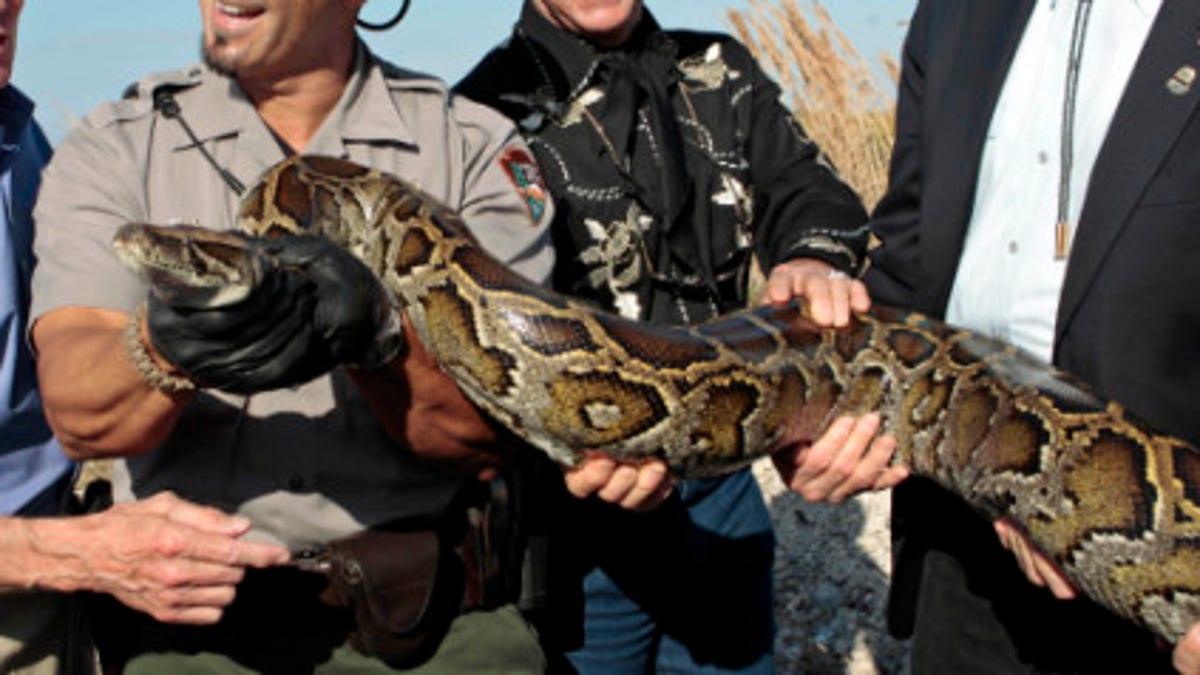
Jan. 17, 2012: Secretary of Interior Ken Salazar, right, Ron Bergeron, second from left, of the Fish and Wildlife Service, National Park Service Supervisor Ranger Al Mercado, second from left, and Sen. Bill Nelson, D-Fla., left,hold a 13-foot python in the Everglades, Fla. (AP Photo/Alan Diaz)
If you have 30 minutes and $25, and you can make your way to the Everglades, you can be a snake wrangler.
The Sunshine State is hosting a month-long “Python Challenge" beginning Jan.12 with cash prizes of up to $1,500 for the biggest snakes caught. Wildlife officials urge caution, but beyond the online course and the fee, there are no other requirements to hunt down the Burmese pythons, which can reach nearly 18 feet in length and have devastated much of the southern Florida ecosystem.
“Aside from the obvious goal of reducing the Burmese python population in the Everglades, we also hope to educate the public about Burmese pythons in Florida and how people can help limit the impact of this and other invasive species in Florida,” said Carli Segelson, a spokeswoman for the Florida Fish and Wildlife Conservation Commission. “We are also using the Challenge to gauge the effectiveness of using an incentive-based model as one tool to address a challenging invasive species management problem.
[pullquote]
The unorthodox approach is evidence of Florida wildlife officials’ desperation as much as their innovation. Since the Southeast Asian species was introduced to the region by irresponsible pet owners, the population of wild pythons has exploded. Experts believe there could be tens of thousands of the giant snakes living in an 8,000-square-kilometer region of southern Florida. The voracious predators have devastated the native species like deer, bobcats and raccoons.
Just last summer, researchers euthanized the largest python ever found in the Everglades -- a 17-foot snake that was carrying nearly 90 eggs -- proving that the reptile species has a strong foothold in the Florida swampland.
The commission’s website includes tips on how to identify Burmese pythons -- and how to kill them. Recommended methods for dispatching the animals include hacking off their heads with a machete or shooting them with a gun.
“Whichever method they use, hunters have an ethical obligation to dispatch the snake as humanely as possible,” Segelson said.
Snakes caught as part of the contest must be delivered to official drop-off sites with 24 hours. Researchers will log data that may be helpful in understanding the snakes' patterns, but then the snakes will be given back to the hunters. All American Gator, which harvests wild alligators for use in clothing, accessories and furniture, has said it will buy larger specimens.
Michael Dorcas, a herpetologist at Davidson College, says that the Everglades were uniquely suited for an explosion in the python population. In an interview with Yale Environment 360, Dorcas said it remains unclear just how big a geographic range these snakes might eventually occupy or how much ecological damage they could ultimately cause. What is clear, he said, is that it will be extremely difficult, if not impossible, to remove the snakes from southern Florida.
“You can go out and you can find pythons, but you can’t go out and find all the pythons — in any area,” Dorcas said. “They’re very secretive animals. And when you have a landscape that is very vast and inaccessible, it makes it very difficult to find these snakes.”
Burmese pythons are generally not dangerous to humans because the snakes are often afraid of a person’s higher stature. Still, the snakes are capable of killing a child and some experts say the larger specimens could even overpower and kill an adult in certain circumstances. The Burmese python kills by squeezing its prey, then swallowing it.
Nearly 400 people have registered for the Python Challenge so far and entered a program that may seem inadequate to become a snake wrangler, but wildlife officials say that entrants will have the opportunity to participate in additional training later this week.
The FWC will also have an enhanced presence out in the everglades region during the event to make sure that participants are following the rules, as well as, keeping hunters safe.
“Anytime folks go out in the woods we expect them to use extreme caution, especially when handling a reptile as large as the Burmese python,” Segelson said.
Some feel that the snake hunt could have potentially negative effects, and that the explosion of Burmese python in the region is not as bad as people may believe.
"We feel that it is not in the best interest of state wildlife to allow a snake hunting contest in Everglades National Park. The abundance of pythons in the Everglades has been greatly exaggerated and there has been a significant drop in numbers since winter 2010," Melissa Coakley, a spokeswoman with the Florida-based Suncoast Herpetological Society said in a statement to FoxNews.com.
"Coordinating a contest with cash awards could potentially encourage people to bring in captive animals from other states. This contest is awarding $1,500 to the hunter with the largest specimen. There is a good chance that some hunters may have entertained the idea of purchasing, very inexpensively, a large adult Burmese python for the sole purpose of killing it and collecting the bounty."
Coakley also said that there is the potential for the hunters without extensive training of being put in danger
"Despite what has been portrayed in popular reality television shows, the Burmese pythons in the Everglades can be extremely dangerous when provoked. It takes a great deal of hands-on practice before one is able to master the art of catching and safely handling large constrictors. There is also the danger of hunters unwittingly killing native snakes while in the Everglades."

